

The Great Hubble. This lesson plan may be used to address the academic standards listed below.

These standards are drawn from Content Knowledge: A Compendium of Standards and Benchmarks for K-12 Education: 2nd Edition and have been provided courtesy of theMid-continent Research for Education and Learningin Aurora, Colorado. Grade level:6-8Subject area:scienceStandard: Understands the nature of scientific inquiry.Benchmarks: Understands the nature of scientific explanations (e.g., emphasis on evidence; use of logically consistent arguments; use of scientific principles, models, and theories; acceptance or displacement based on new scientific evidence). Knows possible outcomes of scientific investigations (e.g., some may result in new ideas and phenomena for study; some may generate new methods or procedures for an investigation; some may result in the development of new technologies to improve the collection of data; some may lead to new investigations).
Hubble Reveals Creation Confirms God Created the Universe. Free 6-8 Teacher Resources. Good Astronomy Activities on the WWW. By Andrew Fraknoi (Foothill College & A.S.P.) © copyright 2000 Project ASTRO, Astronomical Society of the Pacific, 390 Ashton Ave., San Francisco, CA 94112 Reproduction of any kind without express written permission is forbidden.
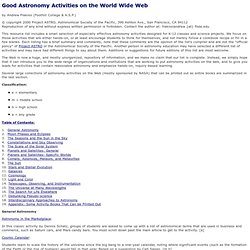
Contact the author at: fraknoiandrew {at} fhda.edu This resource list includes a small selection of especially effective astronomy activities designed for K-12 classes and science projects. We focus on those activities that are either hands-on, or at least encourage students to think for themselves, and not merely follow a cookbook recipe or fill in a few blanks. Each listing has a brief summary and comments; note that these comments are the opinion of the list's compiler and are not the "official policy" of Project ASTRO or the Astronomical Society of the Pacific. The Web is now a huge, and mostly unorganized, repository of information, and we make no claim that our list is complete.
Space. Matariki - Matariki Stories. Warning: Parameter 1 to cms_module_Lang() expected to be a reference, value given in /home/sweetchi/public_html/matarikievents.co.nz/cms/lib/classes/class.module.inc.php on line 2083 Warning: Parameter 1 to cms_module_Lang() expected to be a reference, value given in /home/sweetchi/public_html/matarikievents.co.nz/cms/lib/classes/class.module.inc.php on line 2083 Warning: Parameter 1 to cms_module_Lang() expected to be a reference, value given in /home/sweetchi/public_html/matarikievents.co.nz/cms/lib/classes/class.module.inc.php on line 2083 Te Pito o Watea "The Creation of First Light" It was Tane who was responsible for the distribution of Te Whanau Marama - the stars.
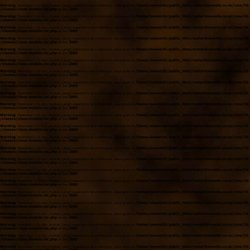
Tane's role as the creator of the night skies is told in a number of stories. Tane is said to have visited his brother Tangotango to congratulate him on the brilliance of his children - the sun, moon and stars. Tane next asked for and recieved the stars, and a dim light soon spread from Ranginui and filled our world.
Resources for Teachers. Skip to main content Carter Observatory Search.
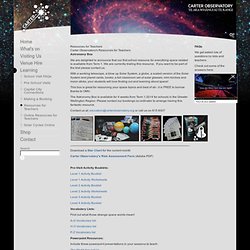
Www.carterobservatory.org/sites/default/files/content/planisphere_bw_const.pdf. Www.carterobservatory.org/sites/default/files/content/Star Chart - Jun 2013.pdf. Www.carterobservatory.org/sites/default/files/content/SCOnline_teacher_guide.pdf. Www.carterobservatory.org/sites/default/files/content/SCOnline_student_pack.pdf. AstronomyNZ - Sun and Moon. The Sun and planets to scale The Sun moves from Leo into Virgo on September 17.
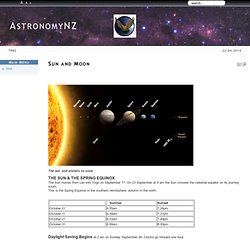
On 23 September at 9 am the Sun crosses the celestial equator on its journey south. This is the Spring Equinox in the southern hemisphere, autumn in the north. Daylight Saving Begins at 2 am on Sunday September 29. Clocks go forward one hour. Perigee (closest orbital point to the Earth): October 11 at noon Apogee (most distant orbital point from the Earth): October 26 at 3 am Lunar conjunctions. Free Educational Videos for K-12 Students. Education and Museums. Kupe - Voyaging by the Stars. Skip to content Register Registering with NZ On Screen means you can: save favourites comment on and discuss titles receive updates via email about what's happening in the site – if you want to Register now We won't share your data with anyone (see our Privacy Policy) and we won't spam you.
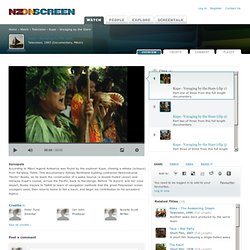
Close Main navigation You are here: Home › Watch › Television › Kupe - Voyaging by the Stars Kupe - Voyaging by the Stars Television, 1993 (Documentary, Māori) In this section. Talesresource.tepapa.govt.nz/teachingResources/words.pdf. A Cape of Stars - Tales from Te Papa. Connected - Teachers' Notes. Teacher Resources. KS3 Bitesize Science - Astronomy and space science : Activity. Space Revealed.
Nature of Science Teaching Activities / Nature of science / Home - Science Online. The Nature of Science strand is described in the science learning area as the overarching and unifying strand.

How might this influence our teaching and our choice of teaching activities? What teaching activities will help us teach the nature of science? The teaching activities in this section provide examples for how we might adapt other activities to meet the aims of the Nature of Science strand. The Nature of Science strand has four achievement aims which are summarised as: Understanding about science, Investigating in science, Communicating in science, Participating and contributing. Rather than teaching these separately, most teaching activities are likely to involve students in more than one of these aspects. Partner resources. Partner resources The resources listed here were developed exclusively for our Space Place Partners.
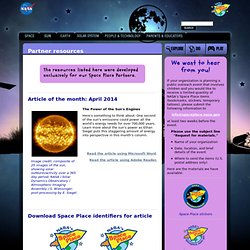
Article of the month: April 2014. StarChild: A Learning Center for Young Astronomers. The StarChild site is a service of the High Energy Astrophysics Science Archive Research Center (HEASARC), Dr.
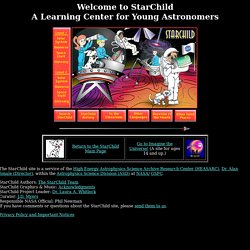
Alan Smale (Director), within the Astrophysics Science Division (ASD) at NASA/GSFC. StarChild Authors: The StarChild Team StarChild Graphics & Music: Acknowledgments StarChild Project Leader: Dr. Laura A. Whitlock Curator: Responsible NASA Official: If you have comments or questions about the StarChild site, please send them to us. Space Shuttle Mission Games. <center><div class="site_errors"><div class="floatType_site_error_top"></div><div class="floatType_site_error"><table summary="layout table"><tr><td bgcolor="#000000"><font color="#ffffff"><h2><img src="/templateimages/redesign/modules/overlay/site_error.gif" title="Site Error" alt="Site Error"/>There's a problem with your browser or settings.

</h2></font><font color="#ffffff"><p>Your browser or your browser's settings are not supported. To get the best experience possible, please download a compatible browser. If you know your browser is up to date, you should check to ensure that javascript is enabled. Multimedia - Video Gallery. Featured Images and Galleries. Engineering Design for Human Exploration. Space Life Sciences. Welcome to Cool Cosmos! Part 1 of 2 Tūhoe legends surrounding the creation of star constellations Waka Huia TVNZ 31 July 2011.
Southern skies – Night sky. Southern hemisphere skies offer dazzling spectacles for night viewing, some of which cannot be seen from the northern hemisphere. Clear skies are usual over much of New Zealand, and it is possible to get fine views of the Milky Way and its neighbouring galaxies, the Magellanic Clouds. The most recognisable constellation (pattern of stars) in the sky is the Southern Cross, along with its associated features, the Jewel Box and Coal Sack.
Many of the sights that are visible from the northern hemisphere can also be seen from New Zealand. The constellations of Orion and Scorpius are prominent at certain times of the year. However, New Zealand is too far south to see Polaris, the pole star, or the Great Bear (Ursa Major). The changing night sky As the sun sets and darkness descends, a number of different features become visible in the sky: the moon, thousands of stars, sometimes one or more planets, faint hazy patches of light and dusty dark regions. An upside-down view How to cite this page: Powered by ICR. Teaching astronomy and space: Models of the Solar System; Earth, Sun and Moon. Life Cycle of a Star. Space. Kids' Club. Skip to main content NASA Kids Club › Text Only Site Let's Go to Mars! Kids Space. Rockets. Satellites. Space revealed. Astronomers studying space have two big problems: A lot of things in space seem invisible – they do not give out light we can see.
Scientists cannot leave the Earth to go and collect pieces of stars and galaxies to study. Using different wavelengths of light There are special telescopes and other instruments that can detect light we cannot see with our eyes. Look up into the sky at night. But there is a lot you can’t see, even with a powerful telescope, because not everything in space gives out light we can detect with our eyes. Studying stars from a distance Stars and galaxies are too far away for us to send spacecraft to collect samples to study. The light of the electromagnetic spectrum is the key to finding out about space without leaving Earth. New Zealand astronomers There are a number of astronomers in New Zealand, and on this website you can find out about how two of them use the electromagnetic spectrum to: Astrophysics – the new astronomy. Animations and Interactives. Pollination. World Ecosystems. Biomes. What Is An Ecosystem. Coral Reefs: good for marine life, good for us. Teaching astronomy and space: Models of the Solar System; Earth, Sun and Moon.
The Sun - Our Nearest Star (1981) - Part 1 of 2. Amazing Documentary in HD. The Biggest Stars In The Universe. How Stars are Formed.